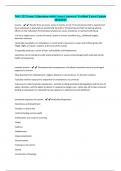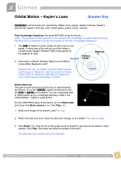NSG 322 Exam 2-Questions with Correct Answers/ Verified/ Latest Update
2024/2025
trauma - ✔️✔️-Results from an event, series of events, or set of circumstances that is experienced
by an individual as physically or emotionally harmful or threatening and that has lasting adverse
effects on the individual's functioning and physical, social, emotional, or spiritual well-being
-Can be a single event, a series of events, and/or a chronic condition (e.g., childhood neglect,
domestic violence)
-Generally overwhelms an individual's or community's resources to cope, and it often ignites the
"flight, flight, or freeze" reaction at the time of the events
-Frequently produces a sense of fear, vulnerability, and helplessness
-Reactions can be temporary with acute symptoms or severe and prolonged with enduring mental
health consequences
complex trauma - ✔️✔️-Developmental consequences of multiple traumatic events or prolonged
exposure to trauma
-May develop from maltreatment, neglect, physical or sexual abuse, or domestic violence
-Typically involves exposure to sequential or simultaneous occurrences
-Exposure to initial traumatic experiences - and the resulting emotional dysregulation and the loss of
safety, direction, and the ability to detect or respond to danger cues - often sets off a chain of events
leading to subsequent or repeated trauma exposure in adolescence and adulthood
emotional responses to trauma - ✔️✔️Immediate Responses:
-Numbness and detachment
-Anxiety or severe fear
-Guilt (including survivor guilt)
-Exhilaration as a result of surviving
-Anger
-Sadness
-Helplessness
-Depersonalization
-Disorientation
-Feeling out of control
-Denial
-Constriction of feelings
,-Feeling overwhelmed
Delayed Responses:
-Irritability and/or hostility
-Depression
-Mood swings, instability
-Anxiety
-Fear of trauma recurrence
-Grief reactions
-Shame
-Feelings of fragility and/or vulnerability
-Emotional detachment
cognitive responses to trauma - ✔️✔️Immediate Responses:
-Difficulty concentrating
-Rumination or racing thoughts
-Distortion of time and space
-Memory problems
-Strong identification with victims
Delayed Responses:
-Intrusive memories or flashbacks
-Reactivation of previous traumatic events
-Self-blame
-Preoccupation with event
-Difficulty making decisions
-Magical thinking
-Belief that feelings or memories are dangerous
-Generalization of triggers
-Suicidal thinking
,behavioral responses to trauma - ✔️✔️Immediate Responses:
-Startled reaction
-Restlessness
-Sleep and appetite disturbances
-Difficulty expressing oneself
-Argumentative behavior
-Increased use of alcohol, drugs, and tobacco
-Withdrawal and apathy
-Avoidant behaviors
Delayed Responses:
-Avoidance of event reminders
-Social relationship disturbances
-Decreased activity level
-Engagement in high-risk behaviors
-Increased use of alcohol and drugs
-Withdrawal
trauma-informed care (TIC) - ✔️✔️-An intervention and organizational approach that focuses on
how trauma may affect an individual's life and his or her response to behavioral health services from
prevention through treatment
-Incorporates three elements: realizing the prevalence of trauma; recognizing how trauma affects all
individuals involved with the program, organization, or system, including its own workforce; and
responding by putting this knowledge into practice
-Begins with the first contact a person has with an agency; all staff members must be mindful of the
individual's experience of trauma
-Includes program policies, procedures, and practices to protect the vulnerabilities of those who
have experienced trauma and those who provide trauma-related services
-Created through a supportive environment and by redesigning organizational practices, with
consumer participation, to prevent practices that could be retraumatizing
-The ethical principle "first, do no harm" resonates strongly
-Brings to the forefront the belief that trauma can pervasively affect an individual's well-being,
including physical and mental health
, -Stresses the importance of addressing the client individually rather than applying general treatment
approaches
reactive attachment disorder (RAD) - ✔️✔️-Consistent pattern of inhibited, emotionally withdrawn
behavior
-Child rarely seeks comfort or responds to comforting
-May resemble autism spectrum disorder, depression, or disruptive mood dysregulation disorder
Symptoms:
-Limited positive affect
-Irritability
-Sadness
-Fearfulness
-Minimal social responses
Causes:
-Inconsistent care
-Frequent changes in caregivers
-Living in foster homes or orphanages
Assessment: observation of affect, mood, sadness, fearfulness, and social responsiveness
Treatment:
-Involves both the child who has been diagnosed and his or her current caregivers
-Individual and family therapy
-Medication for underlying depression or anxiety
-Bibliotherapy
post-traumatic stress disorder (PTSD) - ✔️✔️-People with this disorder may feel stressed or
frightened even when they're no longer in danger
-Can result from a variety of traumatic incidents, such as mugging, rape, torture, being kidnapped or
held captive, child abuse, car accidents, train wrecks, plane crashes, bombings, or natural disasters
such as floods or earthquakes





